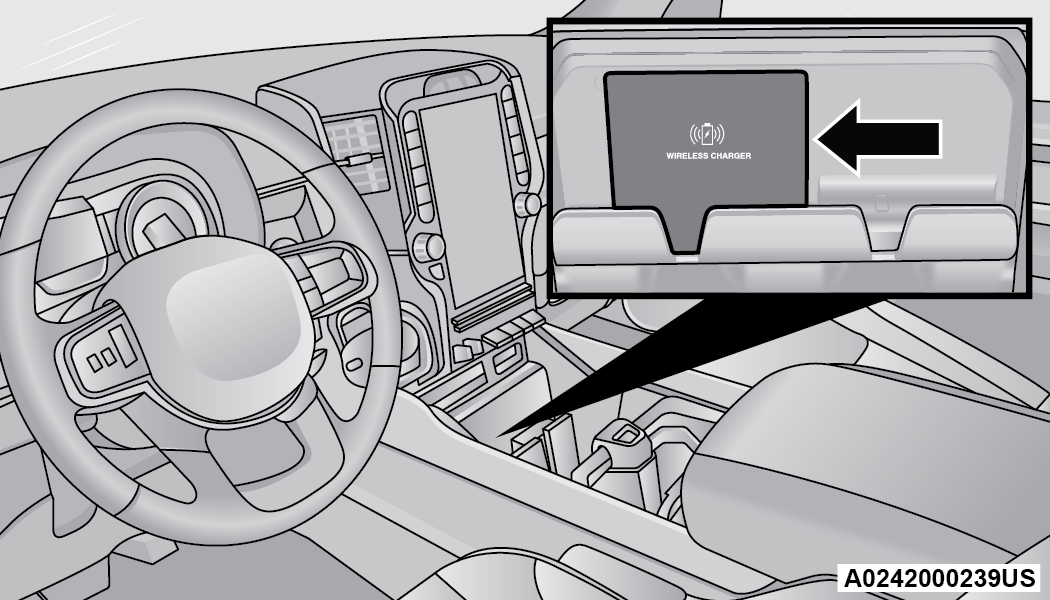
Wireless Charging Pad
Your vehicle may be equipped with a 15W 3A Qi® wireless charging pad located below the center stack, within the storage compartment. This charging pad is designed to wirelessly charge your Qi® enabled mobile phone. Qi® is a standard that allows wireless charging of your mobile phone.
Your mobile phone must be designed for Qi® wireless charging. If the phone is not equipped with Qi® wireless charging functionality, an aftermarket sleeve or a specialized back plate can be purchased from your mobile phone provider or a local electronics retailer. Please see your phone’s Owner’s Manual for further information.
The wireless charging pad is equipped with an anti-slip mat to hold your mobile phone in place, and an LED indicator light.
Place the device inside the prepared area delimited in the mat as shown in the image. Incorrect positioning will prevent the phone from charging.
LED Indicator Status:
-
No Light: Charging pad is idle or searching for a device. Device may not be compatible with the Qi® standard.
-
Blue Light: Device is detected and is charging.
-
Red Light/Flashing: Internal error, or foreign object is detected.
-
Green Light: Device has completed battery charging (if device is equipped to transmit this information).
Important Notes Regarding This Vehicle’s Wireless Charging Pad:
-
The presence of the Near-Field Communication (NFC) function active on a smartphone could signal malfunction anomalies.
-
The ignition must be in the ON/RUN position in order for the phone to charge.
-
To avoid interference with the key fob search, the wireless charging pad will stop charging when any door or liftgate is opened, even if the engine is running.
-
Be sure to place the mobile device correctly (display facing upward, and phone not covering the LED) on the wireless charging pad.
-
If the phone moves on the pad causing the red light to illuminate, the phone will have to be picked up and placed back on the charging pad to resume charging.
-
Wireless charging is not as fast as when the phone is connected to a wired charger.
-
The phone’s protective case must be removed when placed on the wireless charging pad.
-
iPhone® 12 (including iPod®) is equipped with software to protect the device from overheating. When the software is active, the rate of charge is slowed down to protect the device.
-
Phones must always be placed on the wireless charging pad within the outline shown on the pad so that its charging parts connect with the charging coils of the system. Movement of the phone during charging may prevent or slow the rate of charge.
-
Having multiple applications open on the phone while charging will reduce the charging efficiency, and may even shut down an application that is actively running (i.e. Apple CarPlay®). This may also cause the phone to overheat.
-
Wireless chargers may implement certain methods to prevent the phone from overheating during charging such as slowing down the rate of charge. In certain instances, the device may shut down for a brief period of time (when the device reaches a certain temperature). If this happens, it does not mean there is a fault with the wireless charging pad. This may just be a protective measure to prevent damage to the phone.
-
The use of multiple wireless functions at the same time (wireless charging, Apple CarPlay®, Android Auto™) could cause the device to overheat, resulting in limitation of the functions or it turning off. In this case, it is recommended to connect the system using the USB port.
-
Do not place the key fob or any other type of metal/magnetized object inside the mobile phone housing or near the wireless charging pad.
-
With a compatible device placed on the charging pad, and the ignition is cycled to the OFF position, a reminder message may appear on the instrument cluster display to warn the driver.
The key fob should not be placed on the charging pad or within 6 inches (15 cm) of it. Doing so can cause excessive heat buildup and damage to the fob. Placing the fob in close proximity of the charging pad blocks the fob from being detected by the vehicle and prevents the vehicle from starting.